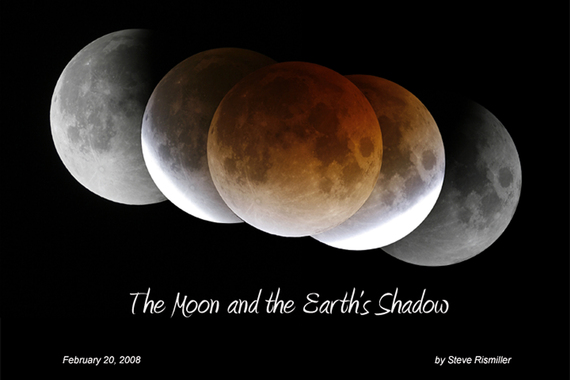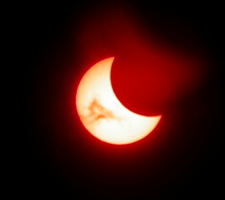Worlds will align, not once, but twice in October, and here's how you can attend the grandest celestial dance.
There will be a total lunar eclipse in the pre-dawn skies of October 8 and a partial solar eclipse on the afternoon of October 23. In each case, the Sun, Moon and Earth form a conga-line in outer space and you won't need a big, fancy telescope to see it (just your two eyes and some safe solar glasses for observing the solar eclipse).
For a lunar eclipse, the Earth is exactly between the Sun and Moon. In this configuration, the Earth casts its shadow onto the Moon and paints the surface with fresh, subtle grays, oranges, and pinks. You'll begin the evening with a normal full moon but as the eclipse progresses you'll notice a rounded shadow slowly creep across the lunar landscape. That is the shadow of your planet. When the Moon is totally in the Earth's shadow, called totality, the Moon will turn an eerie shade of red as sunlight bends through the Earth's atmosphere to reach it. After totality, the Earth's shadow will slowly wipe off the Moon and return it to its normal, full self. The whole lunar eclipse takes three to four hours and is lovely to observe at each stage. The entire aura of the Moon's surface can shift from minute to minute.
For a solar eclipse, the Moon comes between the Sun and Earth and blocks the Sun's light. You absolutely need to use protection. Even a passing, unprotected glance at the Sun can damage your eyes. Once outfitted with safe solar viewing glasses, what you'll see is the crisp, jet-black silhouette of the Moon sliding in front of the Sun's disc. It will look like someone has taken a bite out of the Sun. The Moon will continue on its way and the alignment will be over in a matter of hours.
Imagine the precision. Getting the Moon, at 240,000 miles away, and the Sun, at 93,000,000 miles away, to align with the tiny Earth in the vastness of outer space is a rare treat. But there is a catch: location is important.
Location, Location, Location
The October 8 lunar eclipse will be visible almost anywhere in the U.S., Canada, and Mexico. However, for those on the East Coast, the Moon will most likely set below the western horizon while in mid-eclipse. The farther west you live, the more you will see. Observers in the Midwest will see the Moon reach totality before setting, while star gazers in the Great Plains, West Coast, and Pacific Rim will see the entire eclipse.
Start looking at 5:15am Eastern Daylight Time (EDT) to see the Earth's shadow make its first noticeable appearance on the Moon. Totality is from 6:25-7:24am EDT, and the visible part of the eclipse ends at 8:34am EDT. Enter these times into your phone and set your alarms. This lunar eclipse can be your special treat before work.
For the solar eclipse of October 23, location and timing are important. Once more, the farther west you live, the more you will see. Over the East Coast, the Sun will have already set before the eclipse begins meaning you will miss the entire show. Viewers in the Midwest and Plains will see some of it, while the West Coasters will see the entire eclipse. No matter where you view, however, no one on Earth will see a total eclipse that day. From the Western U.S., you will see about half of the Sun's disc eclipsed by the Moon making it resemble Pac-Man.
For a list of eclipse times for a city near you, please see here.
Safe solar viewing
Don't take chances viewing the Sun. Never use foil wrappers, x-rays, film negatives, smoked glass, CDs, DVDs, telescope eyepieces labeled 'SUN', or sunglasses (even those equipped with UV protection) as solar filters. None are safe.
Use only official, approved, safe solar viewing methods such as #14 welder's glass, eclipse shades, and solar filters made by major manufacturers that fit in front of telescopes or binoculars.
And don't view alone. Hook up with a local astronomy club, observatory, or science center. Chances are they will be having eclipse parties and can share better views of the lunar eclipse and safe views of the solar eclipse. For an astronomy organization near you visit here.
Dean Regas is the Outreach Astronomer for the Cincinnati Observatory and cohost of the syndicated PBS program Star Gazers.


